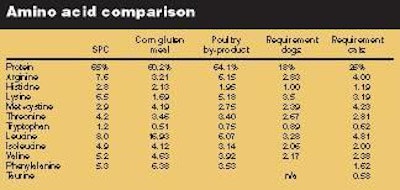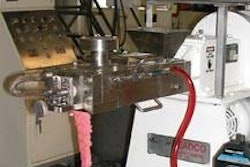
Petfoods are usually prepared as the sole food source for pets. Therefore, all essential nutrients need to be provided in the food, including protein, energy, vitamins and minerals. A satisfactory diet should be nutritionally complete and balanced, digestible, palatable and safe.
The use of plant protein ingredients in petfood has been on the rise in recent years. Soybean meal is a commonly-used plant protein ingredient because of its high nutritional value and consistent supply. Unfortunately, soybean meal has a bad reputation in petfood. This is mainly due to its beany taste and flatulence characteristics. The inclusion level of soybean meal in petfood is therefore limited. Soy protein concentrate can be used in dry extruded, semi-moist or canned petfood. The recommended inclusion level is 5 to 15%.
Processing and production benefits
Processing of soy protein concentrate (SPC), which results in removal of the components that cause the beany taste and soluble carbohydrates, especially oligosaccharides and soluble non-starch polysaccharides, which are responsible for flatulence, is a major advantage.
Addition of SPC to dry extruded petfood can improve production efficiency during extrusion. In semi-moist and canned formulas, SPC can be used for improving the texture, as the protein matrix holds the finished product shape.
Nutritional value
Soy protein concentrate is a nutrient-dense substance. The main nutritional factors of SPC are:
- High protein content and balanced amino acid profile; and
- High protein and amino acid digestibility.
Soy protein concentrate is an excellent protein source for pets, providing high protein content and a well-balanced amino acid profile. Table 1 shows the protein and amino acid content in SPC, corn gluten meal and poultry by-product meal versus the amino acid requirement of dogs and cats. As shown in Table 1, the amino acid profile of SPC complements other protein sources in meeting the essential amino acids requirement of dogs. Taurine is found in meat proteins, but not vegetable proteins, and usually needs to be added as a synthetic amino acid to meet the requirement of cats.
Soy proteins in most commercial petfoods have high digestibility values and are comparable to animal proteins (Huber, et al ., 1994; Zuo, et al ., 1996). Clapper, et al . (2001) found that the apparent ileal digestibility of crude protein and amino acid was higher for SPC than for poultry meal (see Table 2). These authors suggested that SPC could be a viable alternative to poultry meal as a protein source in dry extruded canine diets.
A similar result was reported by Zuo, et al . (1996), who observed that the total amino acid digestibility was higher in a diet containing low-oligosaccharide soy protein compared to a diet containing poultry meal in dogs. Wiernusz, et al . (1995) found that processing soybean meal into SPC increased crude protein digestibility (89.8%) as compared to soy grits (86.7%) and soy flour (87%).
Anti-nutritional factors and stool quality
Soybean meal contains anti-nutritional components that limit its application in petfood. The most important anti-nutritional factors are antigens, trypsin inhibitor activity, oligosaccharides and lectins. Soy antigens can generate antibody production in the bloodstream, initiate inflammatory reaction, damage intestinal surface, reduce the absorption of nutrients and negatively impact the welfare of animals.
Trypsin inhibitor inhibits the activity of trypsin, and therefore reduces the digestibility of dietary protein. Lectins are proteins with blood-clotting properties, causing red blood cells to clump, leading to intestinal damage and reduction in absorption of nutrients. Processing the soybean meal product into soy protein concentrate denatures or removes most of these anti-nutritional factors (see Table 3).
One of the important factors limiting the use of soybean meal in petfood is that consumption by pets can cause flatulence. Soybean meal contains about 15% oligosaccharides (e.g., raffinose, stachyose and sucrose). These oligosaccharides are not digestible by pets and thus cannot be used as energy; but they are available for microbial fermentation in the intestine, resulting in flatulence. These oligosaccharides are mostly removed during the SPC production process, leaving SPC with 1-3% oligosaccharides.
Fecal quality
Besides flatulence, stool quality is a concern, both for pet owners and the environment. The indigestible carbohydrates in soybeans can have adverse effects on stool quantity and quality. Dietary fibers increase the stool's water-holding capacity and increase fecal bulk. The fermentation of the dietary fibers can result in flatulence, large volume/high-moisture stools and possibly diarrhea. Further refining soy to SPC with removal of soluble dietary fibers (non-starch polysaccharides) reduces flatulence and improves stool quality.
It has been observed (see Table 4) that dogs fed an SPC-based diet had a lower fecal output than dogs fed a soybean meal or soy flour-based diet (Clapper, et al ., 2001). Wiernusz (1995) found that dogs fed diets containing a SPC produced less stool volume and higher stool dry matter content compared to dogs fed a diet containing soy flour and soy grits.
Palatability
Pets are very sensitive to the taste of ingredients, so palatability is an important parameter for the quality of petfood. Soybean meal typically has a beany taste that many pets do not like, which limits the application of soybean meal in petfoods. During the production process, ethanol/water extraction removes the components that cause beany taste. Thus, SPC has a neutral taste, color and smell.
In petfood, SPC is typically used as a partial substitute for meat and meat meal ingredients, and as a meat extender in dry and canned petfoods. In dry extruded petfoods, SPC can be used as a bland-tasting protein source that has no negative effect on palatability.
References
- AAFCO, 2003. Association of American Feed Control Officials, Official Publication.
- Clapper, G.M., Grieshop, C.M., Merchen, N.R., Russett, J.C., Brent, J.L. and Fahey, G.C. Jr., 2001. Ileal and total tract nutrient digestibilities and fecal characteristics of dogs as affected by soyabean protein inclusion in dry extruded diets. J Anim Sci 79:1523-1532.
- Huber, T.L., LaFlamme, D. Comer, K.M. and Anderson, W.H., 1994. Nutrient digestion of dry dog foods containing plant and animal proteins. Canine Pract 19:11-13.
- NRC, 1998. Nutrient requirements of swine. Tenth revised edition. National Research Council, National Academy Press, Washington, DC, USA.
- Peisker, M., 2001. Manufacturing of soya protein concentrate for animal nutrition. Cahiers Options Mediterraneennes 54:103-107.
- Russett, C., 1999. Soy concentrate for weanling pigs. Chemurgy Report from Research, SPC-S-34.
- Wiernusz, C.J., Shields, Jr., R.G., Van Vlierbergen, D.J., Kigin, P.D. and Ballard, R., 1995. Canine nutrient digestibility and stool quality evaluation of canned diets containing soya protein supplements. Vet Clin Nutr 2:49-56.
- Zuo, Y., Fahey, Jr., G.C., Merchen, N.R. and Bajjalieh, N.L., 1996. Digestion responses to low oligosaccharide soybean meal by ileally-cannulated dogs. J Anim Sci 74, 2441-2449.

















